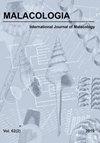sordida Pomacea (Swainson, 1823)和中间Pomacea (f russac in Quoy & Gaimard, 1825)的系统发育系统学和分布(壶足目:壶足科)
IF 1
4区 生物学
Q4 ZOOLOGY
引用次数: 0
摘要
与其相对的生态和经济重要性相比,壶腹科许多物种的研究仍然很少,缺乏明确界定物种或了解其生物地理分布所需的可靠数据。一些,例如Pomacea maculata Perry(1810)和P. canaliculata (Lamarck, 1822),已经得到了很好的研究,部分原因是它们作为入侵害虫的臭名昭著的名声。不幸的是,除了广泛的系统发育研究之外,我们对这两种众所周知的壶腹类动物与其他十几种物种的关系和分布知之甚少。划分这些物种的能力不仅对入侵生物学有意义,而且对本地物种的保护也有意义。壶腹科Pomacea sordida (Swainson, 1823)是巴西里约热内卢州的特有植物。最近的分子分析表明,以前被称为P. sordida的几个种群属于另一个遗传上独特的物种Pomacea intermedia (f本文章由计算机程序翻译,如有差异,请以英文原文为准。
Phylogenetic Systematics and Distribution of Pomacea sordida (Swainson, 1823) and Pomacea intermedia (Férussac in Quoy & Gaimard, 1825) (Caenogastropoda: Ampullariidae)
ABSTRACT In contrast to their relative ecological and economic importance, many species of Ampullariidae remain poorly studied, and lack robust data needed to clearly circumscribe the species or understand their biogeographic distributions. A few, e.g., Pomacea maculata Perry, 1810 and P. canaliculata (Lamarck, 1822), have been well studied, in part because of their notorious reputations as invasive pests. Unfortunately, beyond broad phylogenetic studies, we know little about the relationships and distributions of the dozen or so other species with which these two well-known ampullariids have and continue to be confused. The ability to delimit such species not only has implications for invasion biology, but also for conservation of native species. The ampullariid Pomacea sordida (Swainson, 1823) is endemic to the state of Rio de Janeiro, Brazil. Recent molecular analyses revealed that several populations previously referred to as P. sordida, belong to another genetically distinct species, Pomacea intermedia (Férussac in Quoy & Gaimard, 1825), currently regarded as a junior synonym of P. sordida. To evaluate the validity of this previous study, we examined all of the material identified as P. sordida from the collection of the Institute Oswaldo Cruz and carried out additional surveys across the known distribution of these species. Phylogenetic analyses of COI sequences from 96 snails sequenced for this study, along with additional sequences from GenBank, recovered P. sordida and P. intermedia as sister taxa in a clade sister to P. flagellata (Say, 1829) and P. patula (Reeve, 1856). Surveys of aquatic habitats in the state of Rio de Janeiro recovered both species in allopatric populations with P. sordida primarily restricted to seven sites in the southwestern part of the state, whereas P. intermedia occurred in six sites in the central part of the state, northeast of P. sordida populations. Although cursory examination of male reproductive anatomy of these two species does not provide taxonomically informative characters that allow delineation of these two species, other traits e.g., juvenile shell characters, egg morphology, and kidney shape and arrangement, appear to be informative and provided necessary data to rescue P. intermedia from synonymy with P. sordida.
求助全文
通过发布文献求助,成功后即可免费获取论文全文。
去求助
来源期刊

Malacologia
生物-动物学
CiteScore
2.00
自引率
0.00%
发文量
15
审稿时长
3 months
期刊介绍:
Malacologia publishes papers on all groups of the Mollusca. Malacologia specializes in publishing long papers and monographic treatments. Complete data are especially appreciated. Papers must be of interest to an international readership. Papers in systematics, ecology, population ecology, genetics, molecular genetics, evolution and phylogenetic treatments are especially welcomed. Also welcomed are letters to the editor involving papers published or issues of import to science of the day.
 求助内容:
求助内容: 应助结果提醒方式:
应助结果提醒方式:


